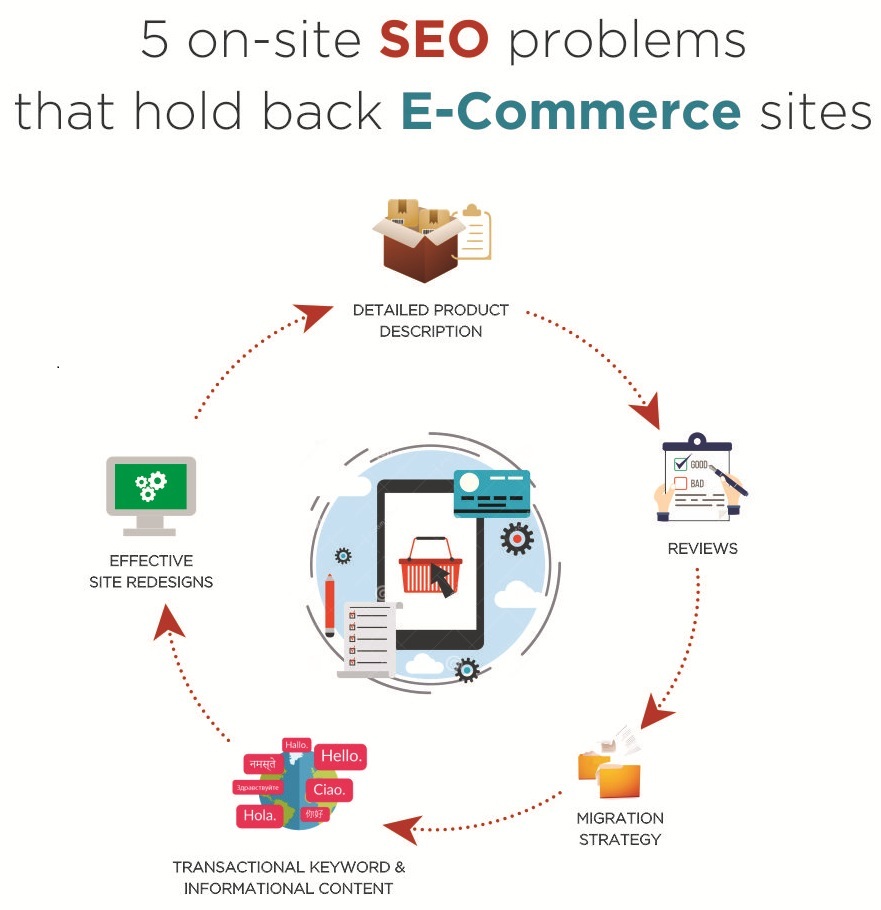The growing usage of smartphones has transformed businesses and lives drastically. Be it hiring a cab, buying clothes, ordering food or availing services online; everything is just a click away at really cheap rates. And, the e-commerce market is expected to grow at a fast pace in the coming years. According to AT Kearney 2016 report, the e-commerce market in GCC countries is expected to grow to US$20 billion by 2020 from $5.3 billion in 2015.
e-commerce sites come across various SEO challenges that obstruct their efficiency. There is a need for business owners, marketing managers, and SEO experts to know these problems; and plan accordingly for their solution. I have jotted down 5 on-site SEO problems which hold back E-commerce sites from delivering to their optimum.

5 SEO problems that hold back e-commerce sites
1. Product description not clear:
Usually, e-commerce sites have a considerable number of products. The quality of a product description can either make or break a sale. It is common for product descriptions to be really short, manufacturer based and automated. With short and automated descriptions, the search engine has limited information.
It is seen that sites with a detailed description of products perform better in search results on all popular search engines. e-commerce website owners should try to include a piece of detailed information; that a shopper needs, to make a decision of purchase. Also, it should be kept in mind to follow the best description format for the products, such as bullet points.
QL Tip: It is advised in general that 350 and 400 words would be enough to describe the main features and benefits of a particular product.
Apart from adding the product description in detail, you can also add blogs to the e-commerce website. Blogs could include keywords that are needed to improve the overall ranking of the website. Backlinko analysis of 1 million search results showed that the average Google first page result is 1,890 words long.
2. Reviews not included on the site:
The user reviews about the product or service affect the search results.92% of consumers now read online reviews.
The impact of adding user reviews is clear and unambiguous. By adding reviews, we can’t say that SEO ranking will improve solely because of getting more reviews. For example, an analysis of over 30,000 businesses was conducted by Yotpo. These businesses added user reviews to their site and measured how this impacted organic search traffic. Within nine months after the implementation of reviews, they found that Google page views per month grew by 30%.
If you also fear of not including user reviews due to negative feedback, then please include it, the results are almost sure to be positive. Also, it will uplift sales. Reviews produce an average of 18% uplift in sales.
3. Improper migration strategy of e-commerce platforms:
Most of the e-commerce sites are built using third-party platforms. This is because they want to focus more on their core business rather than web development.
Sometimes websites outgrow one platform and switch to another as their market shares increases. Also, they switch platforms to gain access to previously unavailable features.

Well, switching platforms can hamper rankings. Many companies wait till they finish the migration of e-commerce platforms and then go for SEO. Don’t do this mistake. Whenever you make any changes in your e-commerce platform, make sure that an SEO professional is always involved in it from the beginning.
4. Not able to develop informational content and focusing more on transactional keywords:
It is very important to add informational keywords that would be able to target the customers who are a bit further up in the funnel. Sometimes, focusing too much on certain keywords usually falls under the failed strategy. For example, it is very difficult to rank for keyword “money”, but this doesn’t mean that you can entirely neglect it.
Apart from adding informational keywords, you should perform a site: search in order to find out which page on-site already ranks best for any given keyword.
Ranking for less competitive phrases adds to the traffic along with improving overall reputation with the search engines. This might be because it influences behavioural metrics. You can take help of SEMrush to find keyword difficulty. When you analyze your existing rankings to see which keywords are already performing well, you can make changes to optimize for those keywords.
QL Tip: Look for keyword rankings in Google Search Console or SEMrush to identify keywords ranking on the second page or so. If these keywords are ranking without being optimized, take them as a golden opportunity and capitalize on them.
5. Site redesigns which are poor:
You might find sites, that, after redesigning gained traffic and also those which lost all the traffic because of it. The latter one is more painful, a redesign was done to beautify the site, incorporating new features. If you redesign your site, without considering SEO, then this is bound to happen. Those pages that were ranking well can get vanished, the content might get changed; thereby, turning a win-win situation to a lost one.
Whenever you change URLs, make use of 301 redirects. This will retain the link popularity that is attributed to the site and help the transfers to the new URL. The 301 redirect shows that indexed URL has moved. The search engine then de-index the old URL and index the new one.
It is advised to create a benchmark metrics including rankings of the site, home page rank, domain authority, and the no. of pages that are indexed in Google with the site: domain.com search. This will be beneficial for comparisons post-launch.
Concluding Lines:
Start looking at your site and take out problems, if any, related to the information that you have provided on your website. By analyzing the problems and fixing those on time, you will able to rank high in the search results of search engine.
Your valuable views are most welcome in the comments below.